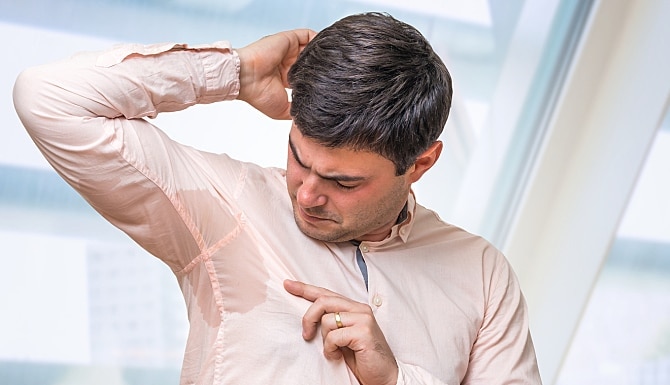Pit stains suck, plain and simple. Ruining shirt after shirt without regard for cost, designer or the fact that it's your favorite, gross yellow underarms may seem like a fact of life, one of those frustrating things that any sweaty guy has to deal with day in and day out. But it's actually not hard to get rid of deodorant stains. All you need is a basic understanding of the science behind them, plus a few tips and tricks, and you'll be home free.
What Causes Sweat Stains?
While it might be intuitive to assume that sweat stains would be a result of sweat itself, the truth is a tad more complex. Perspiration is completely colorless as it seeps out of your pores. According to the International Hyperhidrosis Society, the trouble arises when it mixes with your antiperspirant, more specifically the aluminum compounds inside it. Aluminum serves as an active ingredient in sweat protection. As these two combine, a reaction takes place, giving the solution the yellowish tint you see left behind on your clothes.
How Can You Prevent Them?
As they say, the key to the best defense is a good offense. The same principle applies when you're trying to get rid of deodorant stains. Your best bet is to wash shirts immediately after each wear before the discoloration has time to dry to ensure the stain doesn't become permanent. There are other preventative measures you can take, such as:
Change your antiperspirant. There are plenty of sweat defenders on the market right now that are specifically formulated to prevent sweat stains. Swipe with one of these and reduce the risk of ruining your clothes.
Let deodorant dry before getting dressed. The less residue on your shirt, the better.
Wear darker colors. Don't want to worry about yellowing? Put on a shirt in a shade that'll hide discoloration, like navy or black.
What Can You Do to Get Rid of Them?
When it comes to trying to get rid of deodorant stains, there are about a million home remedies available for you to choose from. Some involve using hydrogen peroxide, while others opt for crushed aspirin and warm water. But think: Do you want to risk a DIY disaster, when there are products made specifically to rid your pits of yellowness? No. So get yourself to the detergent aisle instead.
Which to choose, though? First off, step away from the bleach. Though it might seem like the obvious choice, bleach can actually worsen the problem. Bleach increases discoloration in certain fabrics, the American Cleaning Institute (ACI) says, such as synthetics, silk and wool, as well as damages the fabric beneath it. The ACI suggests using detergents that contain the active ingredient sodium percarbonate, or "oxygen bleach." Designed to be tough on stains without the harsh effects of chlorine-based products, these detergents gently get the job done — plus, they work for all fabrics, regardless of composition or color.
Now, as for treatment, that depends. For more delicate materials like rayon, wool and silk, pre-soaking should do the trick. Simply follow the manufacturer's instructions and you'll be all set. More durable fabrics, on the other hand, like cotton, nylon and polyester, can take a bit more of a beating. So for especially deep stains, first scrub the area with a toothbrush, then let the shirt soak overnight.
One final note: If an article of clothing says "Dry Clean Only," it's probably in your best interest to do just that. Those instructions are there for a reason, after all.
This article was brought to you by Colgate-Palmolive Company, the makers of Speed Stick products. The views and opinions expressed by the author do not reflect the position of the Colgate-Palmolive Company.

